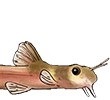Article © Don Kinyon, uploaded January 01, 2002.
One of the most colorful and popular of the Corydoras species is C. sterbai, first described by Knaack in 1962. It comes from Brazil, from the waters of the upper Guapore, near Pontes e Lacerda.
Most of the body and fins are a black base color with silvery white markings. The pectoral and ventral fins are bright orange, and some of the fish have an orange front dorsal spine. In the wild, they will grow to almost two and one half inches, but rarely will achieve this length in the aquarium.
I've had some of these fish for years, and tried to get them to spawn several times, with no success. I was able to change my luck only after I found some wild caught fish. I bought a pair of the wild caughts, put them in with the three males and one female that I'd had, and fed them heavily on live and frozen foods.
The only tank available at the time was a ten gallon, but with three water changes of fifty percent weekly, the environment stayed healthy, even with the heavy feedings. Water was straight out the tap, 7.4 pH, 8 DH, and kept at room temperature; 68 to 74 degrees, F. Filtration was a simple air-driven sponge type, buried beneath the gravel. The only cover in the tank was some bog wood and broad-leafed plants. With this schedule, the females were soon large with eggs, but they still didn't show any signs of spawning.
As luck had it, there was a tank of C. gossei across the aisle of the fish room that were spawning on a daily basis. For the next water change, instead of fresh water, I used the water drained from the gossei tank to fill the sterbai tank. The next morning the fish in the sterbai tank started to spawn like crazy. I can't take any credit for this little trick. A few months back, Scott Saunders of Oodles of Angels gave a talk at a monthly meeting of PVAS, and mentioned this method as a way of getting stubborn pairs of angels to spawn. Apparently, the hormones released into the water during spawning can give the reluctant fish the right idea. Scott knows his stuff about angels, and raises some of the nicest ones around, and his trick seems to work well with catfish, too.
There ended up to be over fifty eggs on the glass, plants, and gravel of the tank. I took out as many as I found and put them into another ten gallon tank with water from the breeding tank. In a week, eggs hatched, and in two more days they were able to start eating. Their first food was micro worms, followed by baby brine shrimp three days later. On these two live foods, the babies grew quickly, and by the time they were a month old, they had grown to be three-eighths of an inch. During this time, water was changed in the rearing tank at a rate of fifty percent twice weekly.
At two months of age, the youngsters have grown to be half an inch, and are starting to acquire the coloration of the parents. They will now take any food offered to them, though it needs to be in small pieces.
If you take the time to work with these Corydoras, I think you will find them an attractive addition to a community tank or an interesting fish to breed.
For More Information:
Aqualog - All Corydoras - Glaser, Schafer, & Glaser pg 52, Pictures & info.
Corydoras - Werner Seuss pgs 13, 15, 37, 106, 107, 183, Pictures & text
There is further information on this species on the Cat-eLog page.
Back to Shane's World index.




